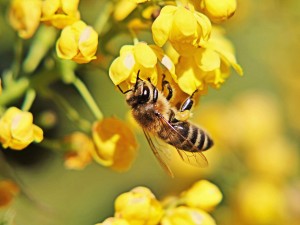Bees are one of the most important and beneficial insects on our planet. Besides producing honey, honey bees pollinate more than half of all our fruit and vegetable crops. Wasps also play a crucial role in our ecosystem: They prey on many of the insects that damage our crops. While bees and wasps are vital to human survival, they can also be harmful. About 100 people per year die from wasp or bee stings and nearly 1 percent of the population is allergic to bee and wasp venom.
When Do Bees And Wasps Become An Issue?
 There are many types of bees and wasps, some of which include Bumble Bees, Honey Bees, Carpenter Bees, hornets, paper wasps, and yellowjackets. In the Midwest, wasps, hornets and yellowjacket colonies usually abandon their nests shortly before winter and then seek shelter until spring. Yellowjackets, often mistaken for bees, are wasps that peak near the end of summer. Yellowjackets often convene in public areas where there is leftover human food and they are attracted to meats and sweet liquids. You can often find them circling around garbage cans and they are notorious for being aggressive and stinging repeatedly. Honeybee colonies can grow as large as 50,000 strong since these bees can survive winters even in northern states.
There are many types of bees and wasps, some of which include Bumble Bees, Honey Bees, Carpenter Bees, hornets, paper wasps, and yellowjackets. In the Midwest, wasps, hornets and yellowjacket colonies usually abandon their nests shortly before winter and then seek shelter until spring. Yellowjackets, often mistaken for bees, are wasps that peak near the end of summer. Yellowjackets often convene in public areas where there is leftover human food and they are attracted to meats and sweet liquids. You can often find them circling around garbage cans and they are notorious for being aggressive and stinging repeatedly. Honeybee colonies can grow as large as 50,000 strong since these bees can survive winters even in northern states.
Where Do Bees And Wasps Build Nests?
Honey Bee nests built from beeswax can usually be found in the tree and rock cavities, while Bumble Bees can be found in wall voids, porches, and old rodent burrows. Paper wasps build the nests you are probably most familiar with. They look like umbrellas and usually hang upside-down from structures. Yellowjackets build papery nests that look like combs. Hornets build the paper nests that hang from trees and other structures and are basketball-shaped.

How To Prevent Wasp And Bee Nests
Preventing bees and wasps from building nests is nearly impossible. There are some paint finishes you can use on outdoor structures to discourage some species like Carpenter Bees, but generally there isn’t much you can do until the insects build their nests. Always use extreme caution when spraying a pesticide and when trying to remove nests while on a ladder.
Sometimes yellowjackets, wasps and hornets build nests in attics, vents, and crawl spaces. It can be dangerous to try to remove colonies from areas like these in your home and it may be best to call trained professionals for removal.






